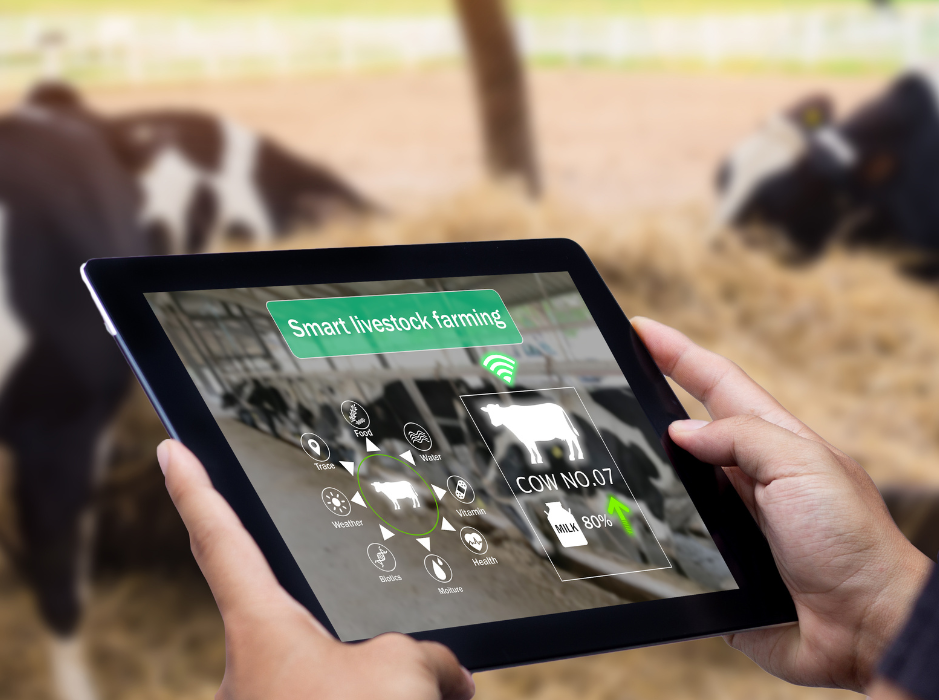Livestock AgTech to Improve Sustainability

This post is also available in:
This post is also available in:
![]() Español (Spanish)
Español (Spanish) ![]() Deutsch (German)
Deutsch (German) ![]() हिन्दी (Hindi)
हिन्दी (Hindi) ![]() Ελληνικά (Greek)
Ελληνικά (Greek) ![]() Português (Portuguese (Brazil))
Português (Portuguese (Brazil))
As climate change becomes more pronounced, consumers expect their daily food products – especially their animal proteins – to be produced in a sustainable and environmentally conscious manner. This means that to do their jobs, farmers are relying on modern technologies that allow them to operate their businesses more efficiently, monitor their carbon footprints, and remain profitable. This is a win-win-win for the environment, farmers, and consumers all over the world.
These agriculture-focused technologies are sometimes referred to as “agtech,” This terminology covers a wide range of products, management tools, and software. Already there is an abundance of livestock agtech products that focus very heavily (and in some cases exclusively) on mitigating the environmental impact of production. Many exciting opportunities are on the horizon for even more tools that improve efficiency and increase production using fewer resources.
AgTech in Today’s Livestock Industries
Sustainability-focused livestock agtech includes a variety of brand-new, up-and-coming, and familiar products. Some of the earliest developments in sustainable livestock production involve nutritional management – one of the most costly and environmentally taxing aspects of animal farming. These include strategic grazing practices, upgraded fencing, reusing feed ingredients, and advanced nutritional research for optimal feeding.
Many of today’s nutrition-focused livestock agtech products are following this pattern but with some modern updates.
For example, recent research has shown that the red algae/seaweed Asparagopsis taxiformis can reduce methane emissions in cattle by as much as 67% when fed as only 1% of an animal’s overall diet. And it has the potential to reduce the emissions by as much as 80% when it covers around 3% of the total diet. There are efforts being made to produce, process, and distribute seaweed as a commercialized ingredient for feeding cattle herds all over the world.
Another updated agtech development is grazing livestock. Instead of relying on practices like fencing and manually inspecting pasture quality, satellites, and drones are being implemented to influence grazing decisions and cattle movement.
In 2021, the United States Department of Agriculture Agricultural Research Service (USDA-ARS) published a study about the positive benefits of using satellites to monitor cattle grazing based on forage growth. This leads to better grazing efficiency for a lower carbon footprint.
In a similar way, satellite-based virtual fencing is being implemented as another way to combat climate issues with grazing practices. This allows for a reduction in soil erosion and overgrazing due to more intensely data-based managed grazing.
Monitoring Environmental Impact with AgTech
Having a way to monitor data and farm performance is crucial for successfully reducing environmental impact. At one time, it was virtually impossible to monitor the output of greenhouse gas (GHG) emissions or efficiency metrics for an entire farm. But today, we have solutions to make this not only possible but very easy to integrate.
These include both farm-wide and animal-specific sensors that can track GHG emissions, including methane and carbon dioxide, monitor environmental conditions, and provide performance data.
Another way that environmental-based data is obtained is through feed efficiency. This includes continuous weight and feed consumption monitoring, which is being done by both hardware and camera “machine vision” monitors that track the animal’s behavior and patterns 24/7. This information is then processed and shared with the farmer through a dashboard with recommended courses of action.
The Power of Artificial Intelligence
Artificial Intelligence (AI) is a powerful tool to interpret data so farmers can make environmentally-conscious decisions when using agtech products and software. There is an abundance of data captured by many of the systems mentioned in this article. But translating all that into actionable information can be a difficult task.
Fortunately, many agtech platforms have their own integrated AI software that does the hard work for farmers and livestock managers. Instead of relying on human recordkeeping and observation, AI is able to ascertain concrete, factual data and translate it into usable information. This reduces many of the human errors that can happen through communication and differences of opinion.
The Future of Livestock AgTech
The current offerings already on the market for livestock farmers are impressive. But many more are being developed every day. No doubt, they will reshape how the majority of livestock farming is done.
On-farm methane digesters – systems that turn GHG from manure into energy or biofuel and solids into a high-quality eco-friendly fertilizer – aren’t necessarily new innovations. But, thanks to greater advancements to improve them and a push to make them more affordable, more farms are able to implement them into their manure management strategy.
Not only does this substantially reduce GHG emissions, but it also cuts the farm’s reliance on conventional power sources.
Technologies are also happening on an industry-wide scale to monitor and incentivize sustainable practices. A great example of this is carbon credits, which is a system that allows farmers to turn their sustainability practices that reduce and recapture carbon emissions into monetary tokens.
Monetizing sustainable, carbon-capturing practices is still in its infancy. However, there are lots of efforts being made in both the public and private industry sectors to make this a mainstream reality for farmers and investors.
Because livestock agtech does a great job of data collection, machine learning, and artificial intelligence, there is much hope that the increased usage of these products will lead to even higher levels of accuracy, greater accessibility, and affordability.
The sustainability movement is not a trendy concept that will soon pass for either consumers or farmers. Rather, it is evolving, as are the farming practices that contribute to the production of animal proteins using fewer resources. A starting point today for farmers is taking advantage of technology that collects data by monitoring and tracking animals and then evaluates it in terms of environment and sustainability.
A plan of attack for every farm is different because no two farms are alike. Farms are small, large, and everything in between. They are located in every state and managed differently. However, a commonality is that most can better utilize resources already on the farm and be efficient and sustainable by looking locally for solutions.
By combining our collective experience with objective data from across the supply chain, all farms will do better, individually and as a whole. With it, the industry can evaluate challenges and adopt solutions that benefit farmers, consumers, and the planet.
Read more
Livestock AgTech to Improve Sustainability
AgTech innovations in Livestock Production
AgTech Advancements in Beef and Dairy Cattle Production
References
https://www.epa.gov/anaerobic-digestion/farm-digester-projects
https://www.darigold.com/this-red-seaweed-could-cut-cows-methane-emissions-by-80-percent/
https://www.climatehubs.usda.gov/hubs/northwest/topic/virtual-fencing-climate-adaptation-strategy
https://www.agproud.com/articles/55308-putting-weight-on-cattle-from-up-above








































































